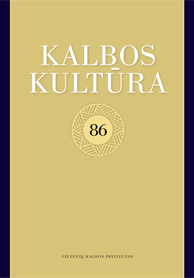MOKINIŲ POŽIŪRIS Į LIETUVIŲ KALBĄ: RYŠYS TARP KALBOS VARTOJIMO, MOKĖJIMO IR MOKYMOSI
PUPILS’ ATTITUDE TOWARDS THE LITHUANIAN LANGUAGE: THE CONNECTION BETWEEN LANGUAGE USAGE, PROFICIENCY, AND LEARNING
Author(s): Aurelija TamulionienėSubject(s): Education, Comparative Linguistics, Baltic Languages
Published by: Lietuvių Kalbos Institutas
Keywords: Lithuanian language; pupil vernacular; language proficiency; language usage;
Summary/Abstract: The article presents the results of a 2018–2019 study aimed at identifying the most prevalent languages in pupils vernacular, showing the correlation between the pupils’ answers and their own attitudes towards Lithuanian classes as well as towards teaching the Lithuanian language and the Lithuanian language in general. Analysis of the data has revealed that, depending on the area of usage, the daily pupils vernacular is dominated by two languages: Lithuanian and English. The Lithuanian language takes the lead (irrespective of the age and gender of pupils) in several areas: Lithuanian is the language spoken at home and the language for reading books. In other areas, such as watching films and browsing, the choice of language depends on the age, with younger pupils opting for the Lithuanian language, while seniors make a transition towards English. Notably, all pupils choose to read their books in Lithuanian. This is an important factor to note, because it is through reading that the language can be empowered. Analysis of the self-grading of the proficiency of the Lithuanian language has showed that girls tend to give themselves higher grades for their Lithuanian language skills compared to boys. The highest self-grades of Lithuanian language skills have been observed among fourth-graders. Beginning with grade 5, the grades shift and the self-grading tends to go down. The study suggests that pupils tend to give themselves high marks in terms of their proficiency in both Lithuanian and foreign language. The main difference is that the majority – more than one-half – of pupils believe that their foreign language skills are excellent; in grading their own Lithuanian language skills, many pupils rated their Lithuanian language proficiency as good. And only a fraction of pupils across all grades believe that their Lithuanian and foreign language skills are very poor.
Journal: Bendrinė kalba (iki 2014 metų – Kalbos kultūra)
- Issue Year: 2019
- Issue No: 92
- Page Range: 1-20
- Page Count: 20
- Language: Lithuanian

